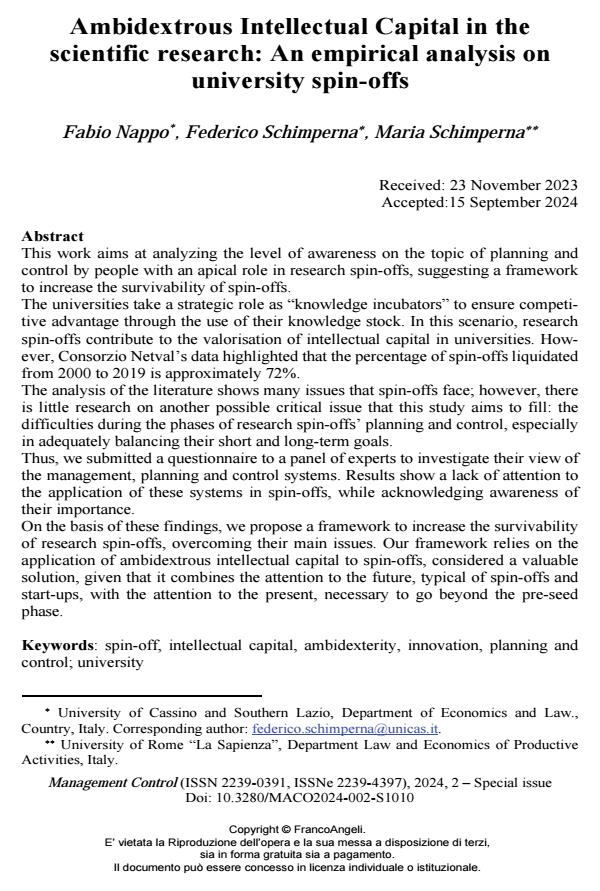Ambidextrous Intellectual Capital in the scientific research: An empirical analysis on university spin-offs
Titolo Rivista MANAGEMENT CONTROL
Autori/Curatori Fabio Nappo, Federico Schimperna, Maria Schimperna
Anno di pubblicazione 2024 Fascicolo 2024/2 Suppl.
Lingua Inglese Numero pagine 24 P. 199-222 Dimensione file 410 KB
DOI 10.3280/MACO2024-002-S1010
Il DOI è il codice a barre della proprietà intellettuale: per saperne di più
clicca qui

FrancoAngeli è membro della Publishers International Linking Association, Inc (PILA)associazione indipendente e non profit per facilitare (attraverso i servizi tecnologici implementati da CrossRef.org) l’accesso degli studiosi ai contenuti digitali nelle pubblicazioni professionali e scientifiche
This work aims at analyzing the level of awareness on the topic of planning and control by people with an apical role in research spin-offs, suggesting a framework to increase the survivability of spin-offs. The universities take a strategic role as “knowledge incubators” to ensure competi-tive advantage through the use of their knowledge stock. In this scenario, research spin-offs contribute to the valorisation of intellectual capital in universities. How-ever, Consorzio Netval’s data highlighted that the percentage of spin-offs liquidat-ed from 2000 to 2019 is approximately 72%. The analysis of the literature shows many issues that spin-offs face; however, there is little research on another possible critical issue that this study aims to fill: the difficulties during the phases of research spin-offs’ planning and control, espe-cially in adequately balancing their short and long-term goals. Thus, we submitted a questionnaire to a panel of experts to investigate their view of the management, planning and control systems. Results show a lack of atten-tion to the application of these systems in spin-offs, while acknowledging aware-ness of their importance. On the basis of these findings, we propose a framework to increase the survivabil-ity of research spin-offs, overcoming their main issues. Our framework relies on the application of ambidextrous intellectual capital to spin-offs, considered a valuable solution, given that it combines the attention to the future, typical of spin-offs and start-ups, with the attention to the present, necessary to go beyond the pre-seed phase.
Parole chiave:spin-off, intellectual capital, ambidexterity, innovation, planning and control; university
Fabio Nappo, Federico Schimperna, Maria Schimperna, Ambidextrous Intellectual Capital in the scientific research: An empirical analysis on university spin-offs in "MANAGEMENT CONTROL" 2 Suppl./2024, pp 199-222, DOI: 10.3280/MACO2024-002-S1010